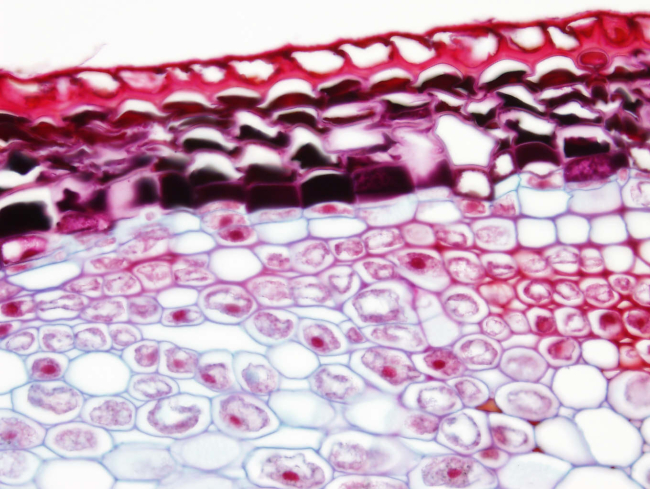Plant tissues. Meristems.
CORK CAMBIUM o PHELLOGEN

Species: elderberry (Sambucus spp)
Technique: paraffin section stained with safranin /alcian blue.
Cells of the cork cambium or phellogen show the typical features of meristematic cells, although they may contain functional chloroplasts. Cork cambium arises from dedifferentiation of parenchyma or collenchyma cells located at the outermost layer of the cortex, after the secondary xylem and phloem formation is started. Sometimes, the first meristematic cells are differentiated from primary phloem or from the epidermis. The first cork cambium of the plant may last for several years depending on of the species (for instance, more than 20 years in the apple tree). Later, sometimes after several years, cork cambium are originated in deeper areas of the stem and from different cells like parenchymatic cells of the secondary phloem. In the roots, cork cambium is originated from the pericycle. Cork cambium usually shows a seasonal activity.
Cork meristematic cells are elongated and form a continuous cylinder in the cortex or are arranged in strands or plates at different depths from the surface. These cells undergo periclinal divisions (they divide in planes parallel to the surface of the organ; see figure) and give rise to phellem, commonly known as cork, outward and phelloderm inward. The three structures, phellem (cork), phellogen (cork cambium) and phelloderm constitute the periderm, a protective tissue that replaces epidermis in stems and roots, which increase in diameter when secondary growth occurs. Cork cambium produces more cork layers than phelloderm layers. As phelloderm usually has seasonal activity, dead cork of the outer layers detaches from the surface anually. The outer bark containing dead cork, and sometimes some phloem, is known as rhytidome.
